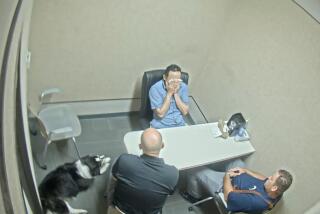Baltimore police officer on trial in death of Freddie Gray takes the stand
- Share via
William G. Porter, the first of six Baltimore police officers to stand trial in the death of Freddie Gray, took the stand in his own defense Wednesday morning, calmly explaining to jurors that he never believed Gray was injured until he found the man unconscious at the Western District police station.
At the station, he held Gray -- whom he knew from the West Baltimore neighborhood where Gray was arrested -- in a “life-saving position” as he waited what “felt like an eternity” for a medic to arrive.
“It was a very traumatic thing for me also,” Porter said. “Just seeing him in the neighborhood every day, and calling his name, and not getting a response.”
Joseph Murtha, one of Porter’s attorneys, got down on the floor of the courtroom, pretending to be Gray, as Porter described what positions Gray was in at different stops the van made as carried Gray to the station.
Gary Proctor, Porter’s other attorney, took Porter through each of the six stops of the van that day. Porter was present at five of them.
Porter was deliberate with his answers throughout the questioning by his attorneys.
He rejected a prosecution claim, based on a police investigator’s interview of Porter, that he had said that Gray had told him that he couldn’t breathe at the fourth stop of the van.
“Absolutely not,” Porter said. In his conversation with Baltimore police Det. Syreeta Teel, he’d said he overheard someone -- who he later learned was Gray -- mentioning having trouble breathing. But he was referring to the very first stop of the van, he said, where Gray asked for an inhaler.
Porter, 26, said he has participated in 150 arrests involving police transport vans, and that none of the detainees in those arrests were secured with seat belts.
NEWSLETTER: Get the day’s top headlines from Times Editor Davan Maharaj >>
Porter faces manslaughter and other charges in connection with Gray’s April death. Prosecutors allege he “criminally neglected his duty” by failing to secure Gray with a seat belt in the police transport van and not calling for medical assistance when Gray requested it.
Gray, 25, sustained a severe spinal cord injury in the back of the van following his arrest on April 12, and died a week later. All six officers charged in his arrest and transport have pleaded not guilty.
Meanwhile, the first defense witness Wednesday disputed the prosecution’s timeline for when Gray was injured and said the local medical examiner got it wrong when she ruled Gray’s death a homicide.
Dr. Vincent Di Maio, a forensic pathologist and former chief medical examiner in San Antonio, said Gray’s injury was “so violent, it’s so high-energy,” that it would have immediately caused Gray to lose control of his body and his diaphragm, which is critical for breathing and speaking.
“This has all the appearances of a single catastrophic injury,” he said.
Di Maio said Gray could not have suffered a severe spinal cord injury at the fourth stop of the police transport van, when Porter found him on the van floor and Gray allegedly said he couldn’t breathe and needed a medic.
The injury had essentially “cut off the head from the body” in a neurological sense, Di Maio testified. He said Gray’s spinal cord was 80% crushed.
“You had a head and a body and they were disconnected,” he said. “You aren’t feeling anything. You aren’t able to move. He was paralyzed. He was quadriplegic.”
Di Maio said he believed Gray was injured between the fifth and sixth stops, and that his death was not a homicide as state medical examiner Dr. Carol Allan found, but an accident.
“It’s just an accident,” he said, “and accidents happen.”
In cross-examination, Chief Deputy State’s Atty. Michael Schatzow asked Di Maio why he had accepted claims from other witnesses that Gray was found in a different position at the sixth stop from the one he was in at the fifth stop. Porter said in his statement to investigators that Gray was in the same position.
Schatzow also questioned Di Maio’s use of an MRI that was taken of Gray’s spine several hours after the injury occurred. Di Maio said that the hospital would have put Gray in a brace that would preserve the injury, so that it wouldn’t have changed much. He also said he relied on a CT scan from shortly after the injury.
Schatzow pointed out that Gray’s spinal cord was not 100% cut and questioned whether Di Maio was sure that Gray would not have been able to speak at the fourth stop in which he talked with Porter.
“Impossible?” Schatzow asked.
“Yes, sir,” Di Maio said.
“Completely impossible,” Schatzow asked.
“Yes, sir.”
ALSO
Syrian refugees arrive in Texas, even as state tries to block them
U.S. Supreme Court closely split on use of affirmative action at universities
A century ago, a popular Missouri newspaper demonized a religious minority: Catholics
More to Read
Sign up for Essential California
The most important California stories and recommendations in your inbox every morning.
You may occasionally receive promotional content from the Los Angeles Times.












